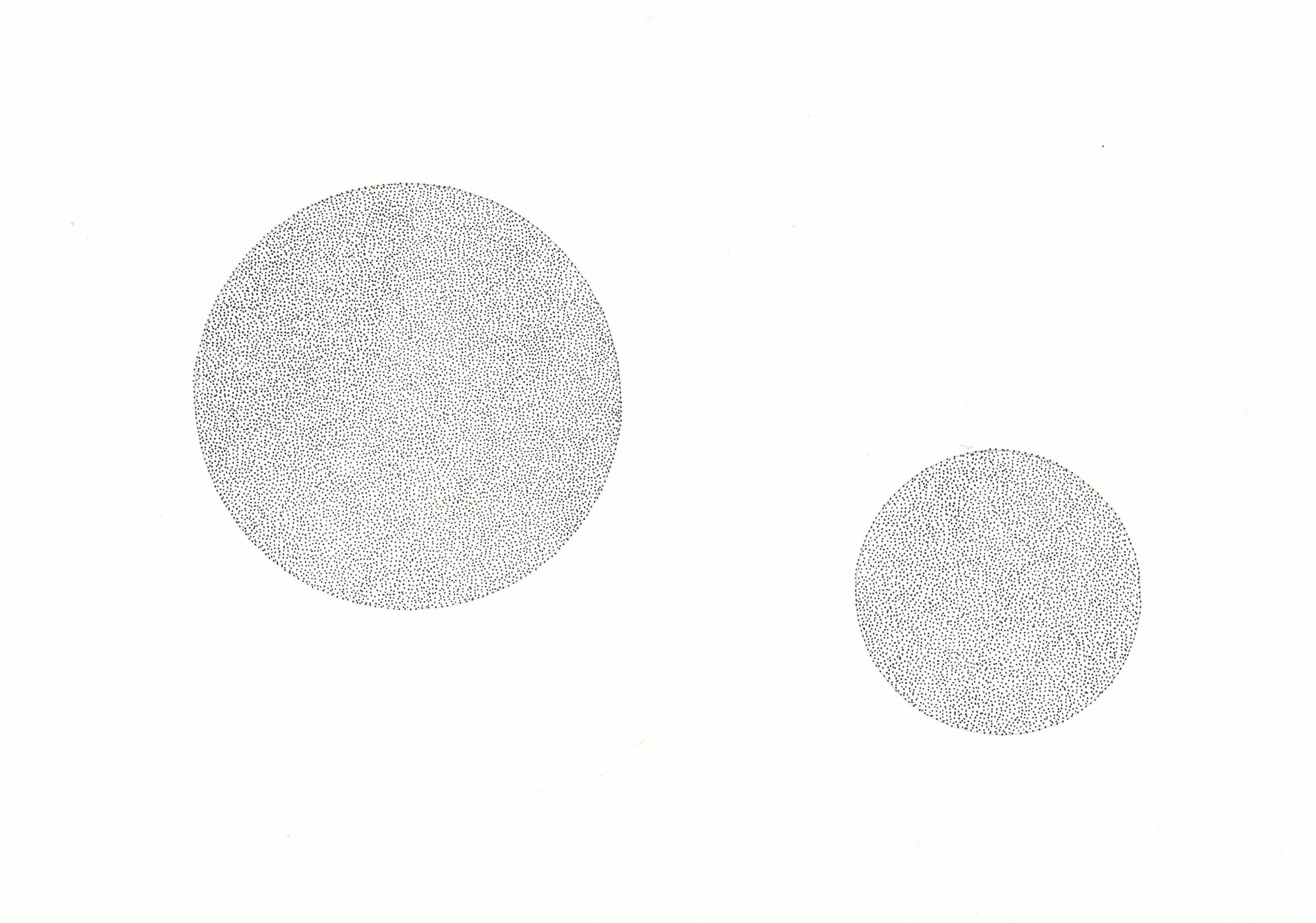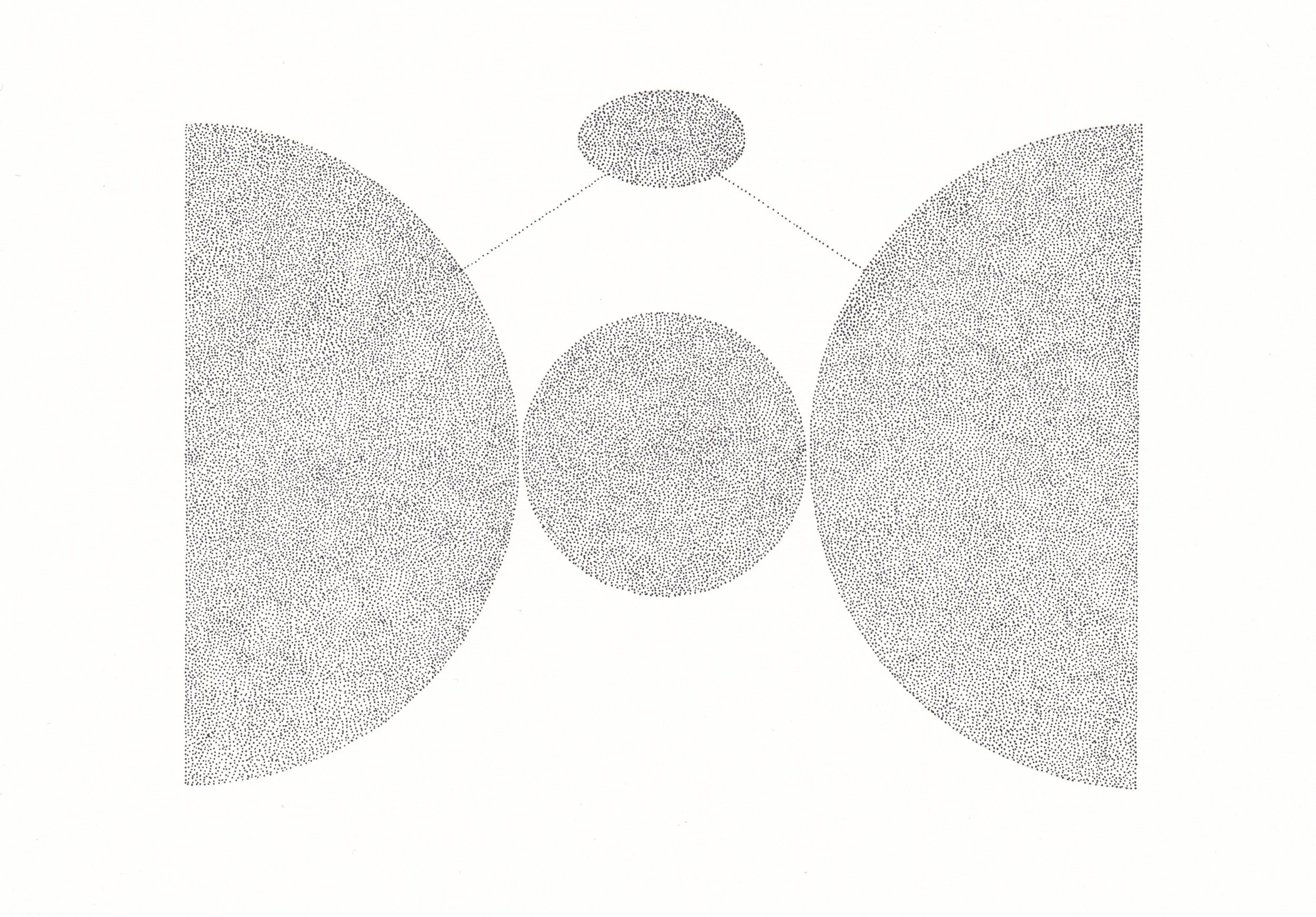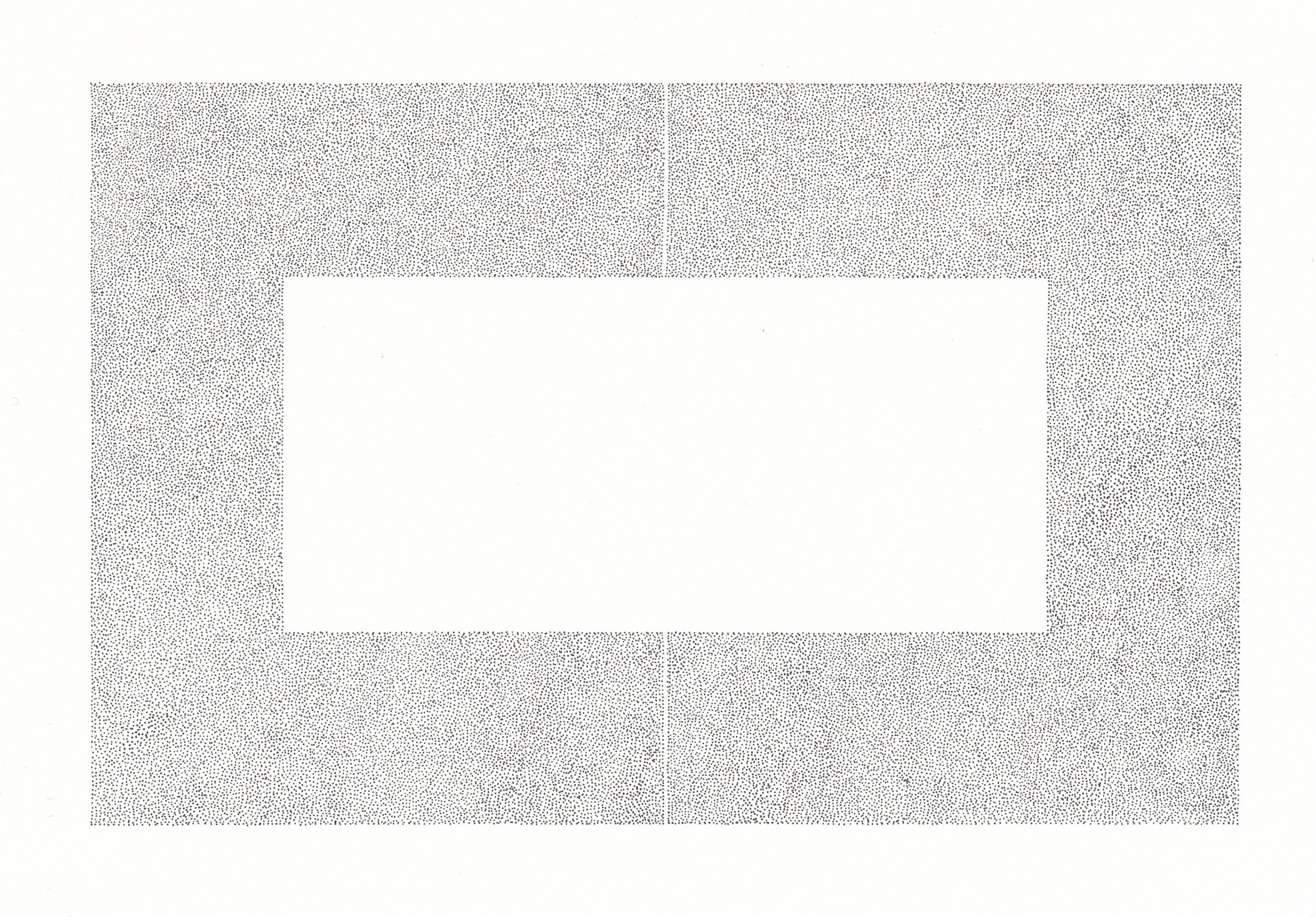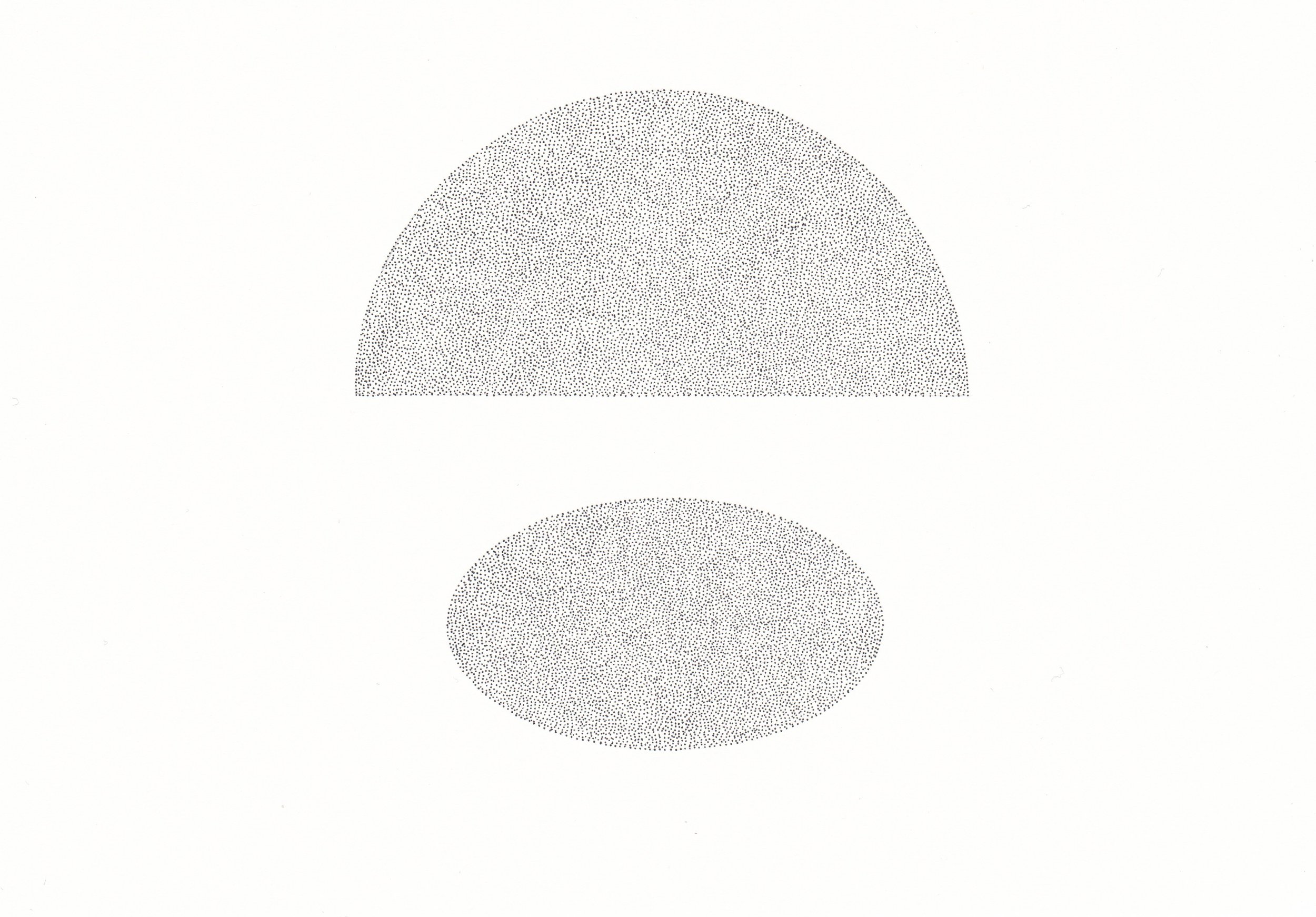At a Certain Point
An exhibition of 32 (mostly) new drawings
Bert Green Fine Art
8 S Michigan Ave., Suite 620
Chicago, IL 60603
Jan 15, 2022 - April 23, 2022
For inquiries or a list of available works please contact inquiry@bgfa.us
Installation photos by Nathan Keay
Mark-making as a meditation
Time, space, and labor
Forms from the void
White noise until the edge of space
Villages / communes / soviets
The individual and the collective
The rise and fall of civilizations
Ok I’ve been listening to the Revolutions Podcast on the Russian Revolution a lot
Conway’s Game of Life
Picking back up from my first exhibition, 2007’s Entry Point
A naive refuge from the burdens of contemporary life
And that’s ok
For now
They want to draw you in
Like atoms
A soft focus
On the scale of perception
Making time
From mark to drawing, from drawing to collection of drawings
An abstract story with a non-linear evolution of forms
An intuited, sacred geometry
And a humble offering for an impossible era
END GAME
Installation photos by Nathan Keay
END GAME was a multimedia installation that plotted the path of consciousness through the end of history. A hypnotic and immersive dirge, it used video, light, sculpture, and sound to ask, “What is the transference method of our psychic energies after the destruction of our planet? Where might the remaining matter of our essence travel to when our physical home is no more?" In this regard, END GAME was both a vessel and a sarcophagus for the human spirit, traveling to an unknown and unknowable destination.
On view at Bert Green Fine Art through December 21, 2019.
WE SEE / WE HEAR / WE ARE
A collaborative project for the Barnes Foundation's Person of the Crowd consisting of three inter-related components: an AI bot (developed by Kyle McDonald), a video (created with students from Overbrook and Central high schools), and a website (developed by Brian Feeney).
Browsing the Blues
Print and two-channel audio installation derived in part from the electromagnetic output of my iPhone while browsing my social media feeds for 27 minutes on January 6th, 2017 beginning at 8:05 ET. Created for "Blinding Pleasures" at Arebyte, London, curated by Fillippo Lorenzin.
Installation photos by Graham Martin from EventPics.
The Akasha Model
The Akasha Model is an attempt to figuratively sonify the thoughts of every sentient being, throughout all history. The audio for the exhibited installation is transmitted via FM radio, and was created using a variety of analog and digital devices including synthesizers, software, contact microphones, a custom-built binaural microphone, and an EEG brainwave-reading device (alpha waves converted to hertz from five different meditations). Additionally, fluorescent glow-in-the-dark silicone casts of my ears are arranged throughout the space.
Originally presented at Bert Green Fine Art.
RAGA/PEAK
RAGA/PEAK was a multi-location, 24-hour audio work presented in three continuous parts. Borrowing from the structure of classical Indian ragas—improvised melodies rendered in five to nine notes, shifted in composition to invoke specific moods for particular times of day—the work is a score comprised of psychoacoustic binaural audio, The Schumann Resonance, messages from people their surroundings, clandestine numbers stations, Mongolian throat singing, iceberg and wind samples, and more. Transmitted over short range FM radio signals to 87.9FM, visitors could experience RAGA/PEAK by visiting three stations—HVCCA, The Field Library, Peekskill waterfront— positioned throughout Peekskill in a geometrically intentional manner, such that traveling from station to station created a contemplative journey between the local environment and the piece itself. Visitors were able to check out FM headphones on site, or were encouraged to bring their own radios with headphones.
Presented as part of Peekskill Project 6.
RAGA/CHAKRA
RAGA/CHAKRA installation view (first and second phases of six). Image courtesy Boulder Museum of Contemporary Art. Photo Richard A. Peterson
An iteration of The Raga Project, RAGA/CHAKRA, was presented at the Boulder Museum of Contemporary Art in the spring of 2015 for the exhibition Flatlander.
The Louisville Project
First Image: still from single channel video, remaining installation images: ©Kenneth Hayden
Press release:
Louisville, KY and IDEAS 40203 welcome NY artist Man Bartlett in his discovery project to promote diabetes awareness for Thrive365 - the mobile health platform which liberates and empowers people with diabetes to enjoy the foods they love. As part of the project Bartlett will be exhibiting select works at Zephyr Gallery that examine the corporate influence and cultural impact of diabetes, as well as creating an interactive installation and “research clinic” to conduct interviews with people with prediabetes and Type 2 Diabetes.
The opening at Zephyr Gallery will be on Thursday February 5th. The artist will be giving a talk about his artistic practice, and how this project relates. You can also follow Man onTwitter, Tumblr and Instagram as he makes his way around town.
Press
Interview: "Meet Man Bartlett […]," LEO Weekly
"Zephyr Project: Where are meets commerce," LEO Weekly (cover story)
ME/ME
Installation view. Left to Right:
Essence of Man
Spray bottle, clary sage, laurel leaf, violet, white pine essential oils, Blessed Thistle,
I Am Encoding, Lovejoy, Miconia Lundelliana, Peridot, Sunflower, True Spirit Flower Essences.
Created by Flower Essence Practitioner Rhoni Groff based off of my social media profiles.
edition of 3 + 1 Tester
2014
I downloaded some new apps today
Inkjet engineer’s print
limited edition of 3 + 1 AP
4’ x 3’
2014
YOU/ME (I wonder if you can hear what I’m hearing)
Single-channel video installation with four-channel audio
6:58, continuous loop
2014
ME/ME was a two-person show with Kristin McIver at CHASM Gallery in Bushwick, Brooklyn, NY. Curated by Jessica C Holburn.
The Object of an Act of Thought
Installation photos by Nathan Keay.
Press release from the exhibition at Bert Green Fine Art:
“The Object of an Act of Thought” brings together recent work in a wide range of media including painting, drawing, collage, animated gif, video, and performance documentation.
The title of the exhibition is drawn from Kant’s notion of the noumenon, which is understood as “a posited object or event that is known (if at all) without the use of the senses.”* Noumenon and its converse, phenomenon, can serve as a framework when thinking about the extent to which we can know things as they are versus knowing things as they appear. The convergence of these two opposing forces within an art object is a guiding principle by which I’ve made the work presented in this exhibition, and employing a variety of artistic devices, I’ve approached each creation through the manipulation of the relationship of a medium to itself.
The drawings follow the tradition of meditative mark-making, guided by an awareness of the act of the pen on the paper over time. They seek to balance an organic chaos within the defined boundaries of a structured plane.
The Case Studies, collages sourced from advertisements in Holiday Magazine, present mid-20th century characters in prototypically American postures with psychologically comical replacements for their heads. Made of anthropomorphized suitcases, cameras and radios they emphasize the relationship between the consumer product and the consumed that defined the post-war American economy, and reveal the culture of innovation that celebrated luxury and the promise of access to a newly minted middle class.
Continuing the tongue-in-cheek approach are “Blue Chip Art” and “Tips for Instagrammers Who Want More Likes.” These one-liners are insider art world commentaries on art about art, the former a reference to the expensive end of the art market that is referred to as “blue chip art,” the latter an update on John Baldessari’s “Tips For Artists Who Want To Sell.” These two works also embody an economy of means: "Blue Chip Art" was created with paint chips appropriated from a hardware store near the artist’s studio, while “Tips..." was outsourced to a Chinese Paint Mill, the contemporary equivalent to Baldessari’s hiring a sign-painter.
The three animated GIFs presented for “The Object of an Act of Thought” were created ritualistically by throwing 12 gold-painted peppercorns around a crystal icosehedron, four different times onto a flatbed scanner, in three iterations. The frames were compiled, animated, and exported with an extreme type of image compression: black and white, with noise dithering. Notably, the gifs are offered for sale utilizing monegraph, a new method to authenticate digital works by using metadata in the bitcoin blockchain to denote current ownership of a particular file by URL.
Two video works, “CIRCLEFEED” and “LINEFEED” are the direct representation of stylized VHS feedback. In “CIRCLEFEED,” a camera was pointed at a television monitor, for “LINEFEED,” the same camera was directed at a connected laptop. The motion was created by the slow, hypnotic movement of the zoom of the lens and slight directional shifts. Both of these videos contain binaural beats (an effect of playing different frequencies on the left and right audio channels to create a phantom "third sound") that can only be experienced on headphones.
“Lost & Found” was a performance for an audience in Amsterdam (via Skype) where I asked people on Twitter what they were afraid of, and what they were looking forward to. I then created a heavily mediated ritual around their responses, as well as what random people were tweeting about these same topics. It was the latest in a long string of actions dating back to 2010 that use Twitter as a medium of artistic creation to attempt to reconcile online and physical audiences under a simple conceit.
In another performance, I recorded myself alone in my studio, auditioning for “The Role of the Artist.” As of this writing, I’m still waiting to hear if I got a callback.
* Source: http://en.wikipedia.org/wiki/Noumenon















































































